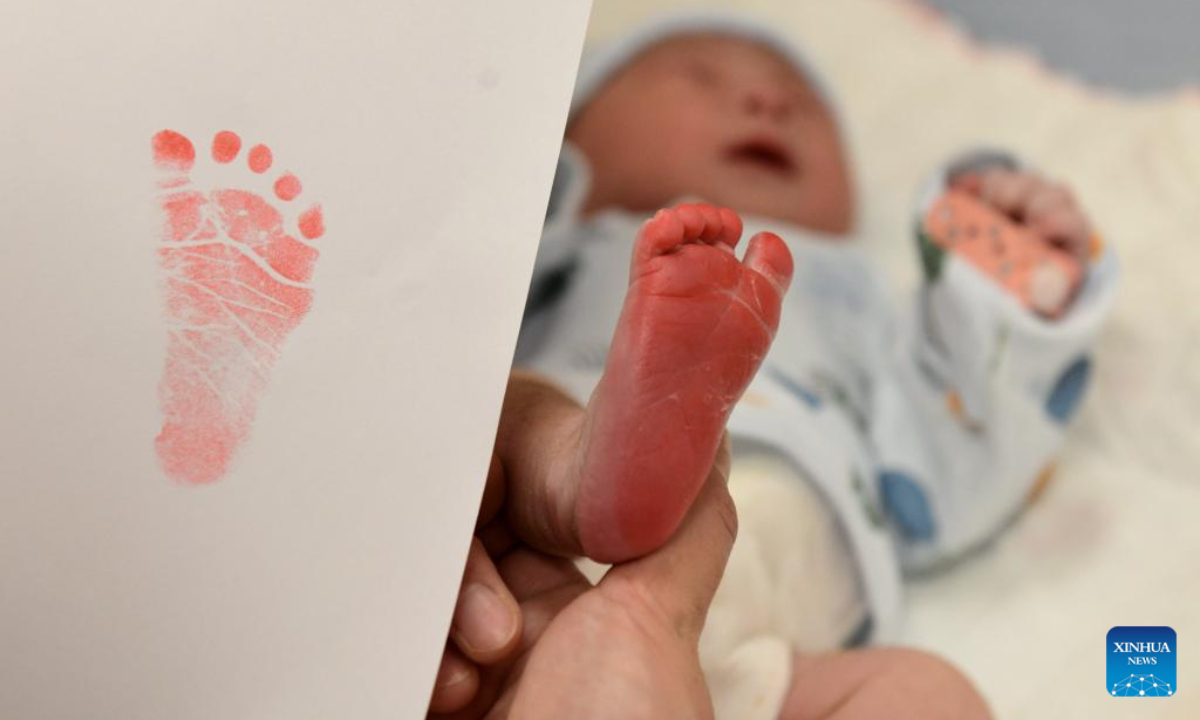
A medical worker gets a newborn baby's commemorative footprint at a hospital in Shijiazhuang, north China's Hebei Province, Jan 22, 2023. Photo:Xinhua
The city of Shenyang in Northeast China’s Liaoning Province will offer subsidies of 500 yuan ($72.9) per month to local families with a third child until the child reaches 3 years old, as part of the city’s latest effort to stimulate population growth.
According a plan to promote long-term and balanced population development issued by the local government, the city has put forward a package of supporting policies from the perspectives of childbirth, childcare, education and housing to raise the level of childbirth, ensure the health of pregnant women and children, and reduce the cost of childbirth, parenting and education.
According to the plan, the city has vowed to maintain the gender ratio at birth, gradually optimize the population structure, and continuously improve the quality of the population through to 2025.
By 2035, the city will further complete the active birth support measures to promote long-term and balanced population development, moderate fertility levels and improve population structure.
The implementation stipulated to strictly implement the provincial regulations on population and family planning including prolonging women’s maternity leave to 158 days from the original 98 days. Meanwhile, fathers will also enjoy 20-day of parental leave.
Couples with children in 3 years and younger can enjoy accumulated a 10-day paid childcare leave each year.
The city will also subsidize local couples with a third child to the level of 500 yuan per month until the child reaches 3 years old.
The city will also roll out a series of housing policies and preferential treatment schemes to families with a second or third child.
The city will also make an all-out effort to develop childcare services to families with children under the age of 3 by supporting kindergartens to provide childcare services to families with children aged 2 or 3.
Multiple Chinese provinces and regions including Southwest China’s Yunnan, Chengdu in Southwest China’s Sichuan and North China’s Inner Mongolia Autonomous Region have also rolled out a series of supporting policies to families with either a second or third child.
In Yunnan, families eligible for the new policies can access a one-off subsidy of 2,000 yuan for their second child and a 3,000-yuan subsidy for their third child between January 1, 2023 and December 31, 2025.
Families with a second or third child can obtain a subsidy of 800 yuan for each child every year until the child reaches 3 years old.
Chengdu and Inner Mongolia intend to life rates of childbirth through increasing the number of local kindergartens and childcare service providers.
In addition, some other provinces and regions across the nation including North China’s Tianjin Municipality, East China’s Anhui and Jiangxi provinces, have attempted to extend the marriage leave to encourage young people wish to tie the knot to get married.
The population in the Chinese mainland in 2022 registered
negative growth for the first time in 61 years, decreasing by 850,000 year-on-year to 1.4118 billion, according to the date released by the National Bureau of Statistics (NBS) in January.
However, demographers suggested that
the number of new births could return to more than 10 million by 2030, as long as there are sufficient economic incentives, according to a report on China’s population development released on Friday.
Global Times




